The Manhood Peninsula
A unique and sensitive environment
The Manhood Peninsula is an environmentally sensitive and unique area which is under threat of destruction from housing development. It is essential to preserve it for future generations and to protect the wildlife that is battling to adapt to climate change and human disturbance.

The beauty and diversity of the Peninsula has enriched our lives – more than ever throughout the lockdown period. In the Witterings and in all our coastal villages our productive arable land is under threat from unsustainable development. It is vital that we all do everything we possibly can to object to urbanisation and further loss of green fields.
If this development isn’t stopped, our villages will lose their identities. They will merge together and the impact to our fragile coastal environment will be irreversible. Our wildlife will be reduced to isolated protected areas as the natural animal corridors are lost under tarmac and concrete.

“The Manhood Peninsula is one of the last and largest relatively undeveloped stretches of coastline between Newhaven and Southampton.”
Natural England’s National Area Profiling
The threat to Britain’s coastal agriculture
Natural England’s classification of agricultural land quality
The Manhood Peninsula has scarce, high-quality farmland. The land under threat on the Western Peninsula lies mainly on the coastal floodplain and has some of the richest soil in the South-East of England. These flat arable fields are surrounded in most cases by ancient hedgerows and small trees. Rifes (deep drainage ditches) cross the land which are currently well maintained by our local farmers.
The Manhood Peninsula is protected by the Isle of Wight. Because of the prevailing south-west winds, it has its own microclimate with intense daylight. It is therefore ideal for market gardens and horticulture. After Brexit, agriculture is ever more vital to our economy to feed our growing population and reduce expensive food imports.


The threat to our diminishing wildlife
Ditches and culverts
In the Manhood Wildlife and Heritage Group’s FLOW project (Fixing and Linking Our Wetlands), they mapped the ditches and culverts as well as green networks for endangered species in the East Wittering and Bracklesham parishes.
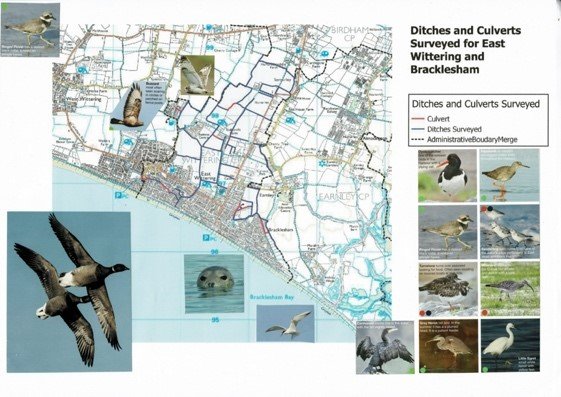
Barn owls, bats and water vole habitat networks
This clearly shows that these networks cover all the fields that developers wish to replace with concrete and tarmac – threatening the habitats of some of UK’s most endangered species barn owls, bats and water voles.
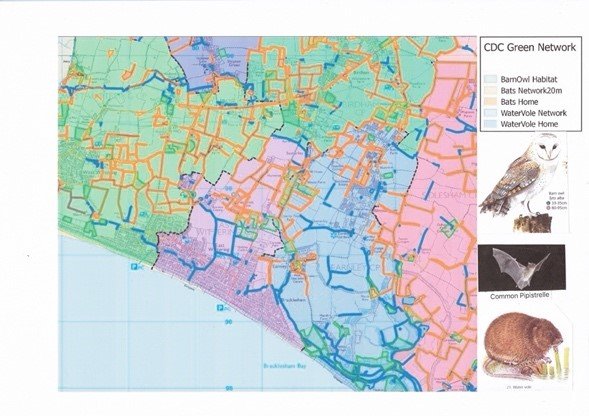
Loss of animal connectivity
If developers gain permission to build across our green fields, animals will be isolated in the protected areas of Chichester Harbour, Pagham Harbour and Medmerry. Their natural corridors will be disrupted. On the remaining small urban green areas, wildlife will struggle to survive human disturbance and predation by household pets.
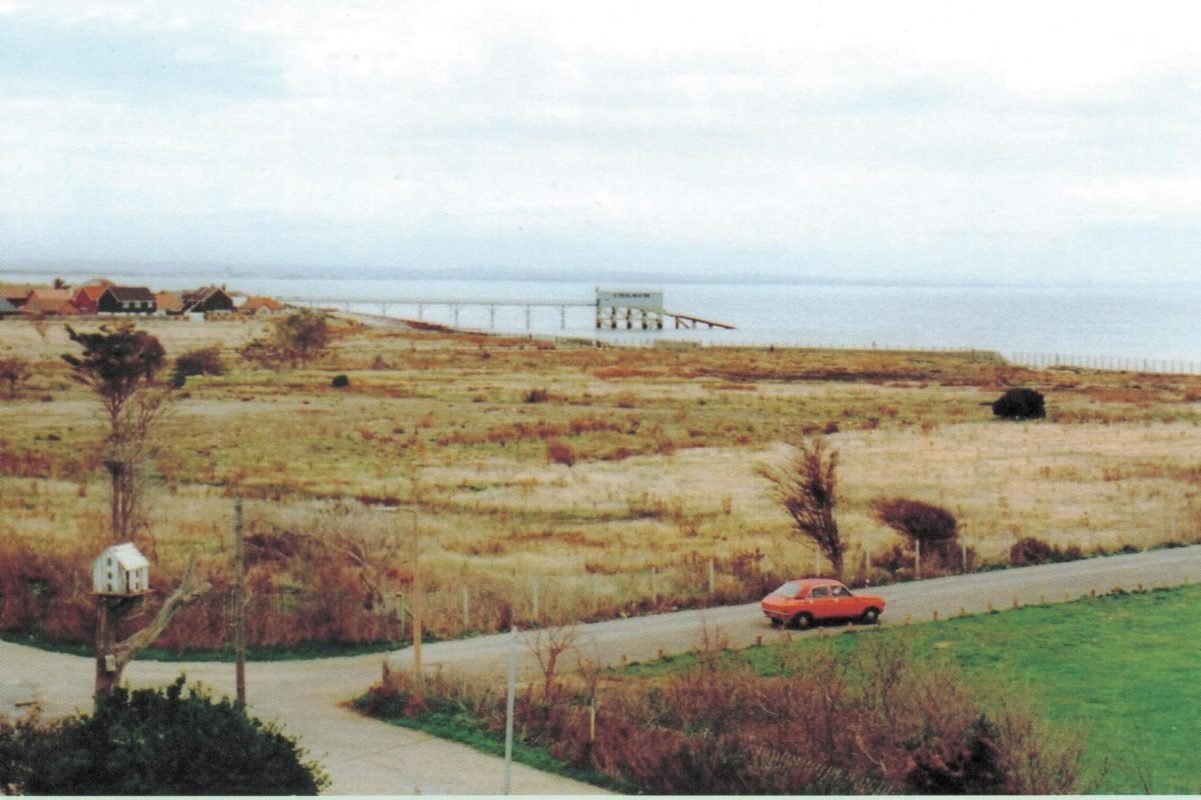
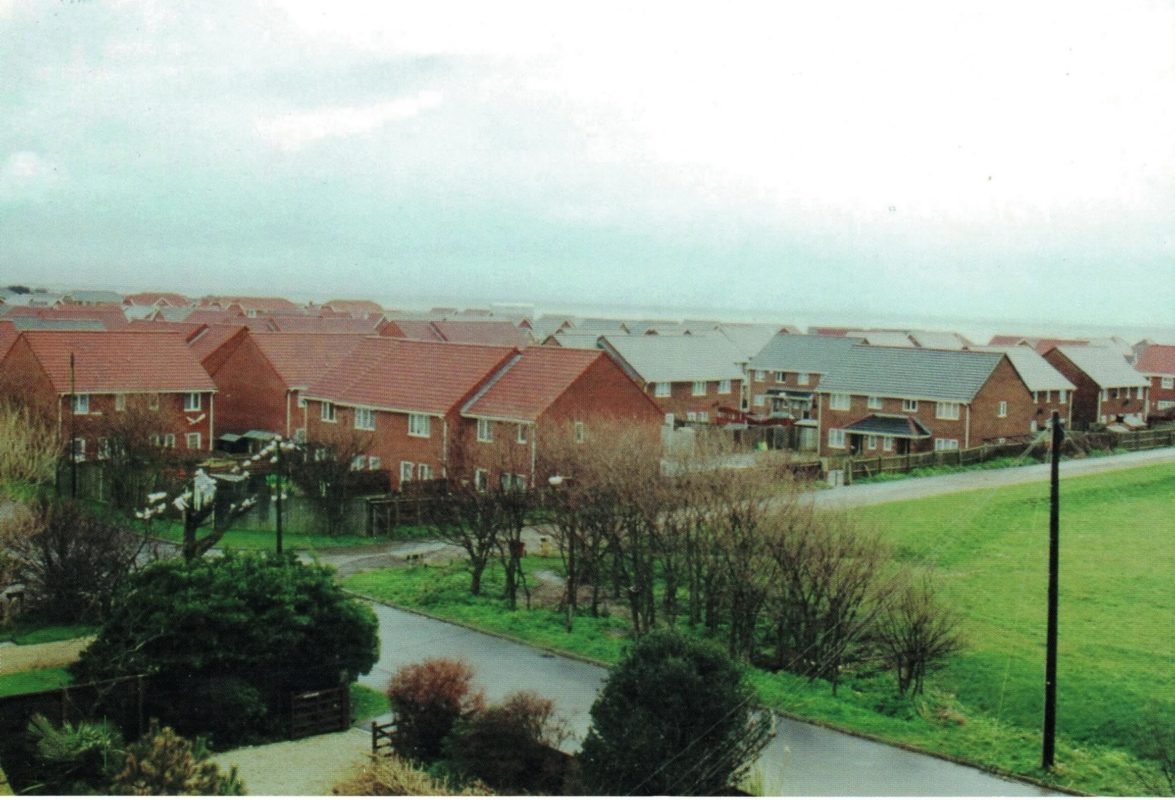
These two photos were taken from the same viewpoint in Bill House Tower ten years apart. The derelict Pontins site with scrub and coastal vegetation before development was a magnet for migrating birds. It is now replaced by a massive housing estate with little habitat for wildlife.
By kind permission of Owen Mitchell, photographer and joint author of A Birdwatcher’s Guide to Pagham Harbour, Medmerry and Selsey Bill
Are you aware?
1. Hedgerows are classed as a priority habitat and provide vital resources for mammals, birds, insects and amphibians
Bats use them as feeding corridors. Adjacent to the hedgerows are field margins of natural vegetation full of wildflowers which provide nectar for pollinating insects and can reduce water and soil run off that prevents soil erosion.


2. Oak trees – numerous on the Peninsula – are the most biodiverse of our native trees and support more life forms than any other
They are host to hundreds of insect species, supplying many birds with an important food source. In autumn, mammals such as squirrels, badgers and deer feed on acorns. We have small herds of roe deer that today roam freely across all arable fields and track across the country lanes. With the increasing traffic these beautiful animals are being killed and maimed on our roads.


3. There are buzzard nesting areas in many locations close to our threatened green fields
As a result birds of prey – including sparrow hawks, which are now in decline – will lose vital hunting grounds.

4. Our most threatened mammal is the water vole
It is present in many of our rifes and ditches on the Peninsula (5-year study by the Manhood Wildlife and Heritage Group). These are shy creatures. Interference with their habitat will seriously threaten their survival.

5. Skylarks are the sound of summer in all our green fields, but be prepared for silence when the bulldozers move in
Skylarks are on the RSPB red list of serious conservation concerns. They nest amongst the crops in all the arable fields in the Witterings.

6. Our threatened fields are under the direct migration flightpath of our waders, ducks and our most celebrated arctic migratory visitors, the dark bellied brent geese
There is a wintering population here of up to 3,000 individuals who feed on crops and grass fields.

7. Great Crested Newts are a protected European species and have been located in various ponds and waterways on the Peninsula
This includes the wetland area at East Head and various ponds located in the Witterings. These animals and their eggs, breeding sites and resting places are protected by law and a license has to be obtained from Natural England if there are plans of any activity that could disturb or damage their habitat.
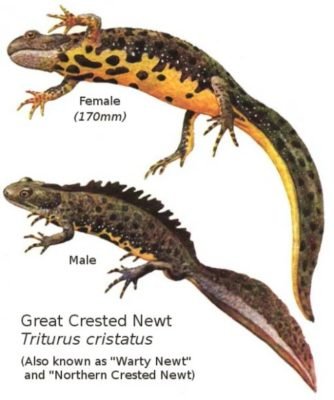
8. 59 different moth species were identified in the Stubcroft fields in 2016 by moth expert Anna Ryder
These include the rare ‘Rest Harrow’. In September 2021 she returned and her latest survey identified 71 species including the red listed rare ‘Portland Ribbon Wave’. These moths were verified by County Moth recorder.
Rest Harrow moth (top) Portland Ribbon Wave (below). With thanks to Simon Green, Stubcroft Farm Campsite (Gold award from Green Tourism)


Other Peninsular creatures in decline include …
Hedgehogs, weasels (one observed recently in Church Farm Lane), stoats, moles, shrews, dormice (last observed near Stubcroft Barns in 2000), harvest and wood mice, slow worms, grass snakes, cuckoos and many red/amber listed birds, pipistrelle and two other bat species (East Wittering Church and Stubcroft barns), etc. There are now less rabbits, an important food source for birds of prey and foxes. Hares, once populating Birdham fields east of A286, haven’t been seen for many years.

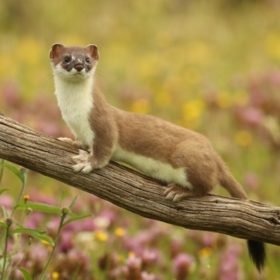


!!! Insect Alert !!!
Most of our threatened fields are in dark areas. Light pollution is a significant but overlooked driver of the rapid decline of insect populations according to the most comprehensive review of scientific evidence to date. Researchers report artificial light can affect every aspect of insects’ lives, from luring moths to their deaths to spotlighting insects to be easily predated. Car headlights also have the same effect. It is now believed that artificial light at night – in combination with habitat loss, chemical pollution, invasive species and climate change is driving insect decline, this threatens to cause a “catastrophic collapse of nature’s ecosystems and their absence would have devastating consequences for life on our planet” (Extract from Guardian article by Environmental Editor, Damian Carrington, 22.11.19)
Pollution alert – affecting wetland habitats and marine life

Sir David Attenborough backs plans to repair Sussex’ kelp forests.
The Manhood Peninsula is a unique area of land that penetrates the sea of England’s beautiful south coast. From the lagoon of Medmerry saltmarshes, where avocets, oystercatchers and other shoreline birds make their home, to the nature reserves of Chichester & Pagham Harbours, the waters of which offer protection and opportunities for breeding seals, fish, crustaceans, kelp and other magnificent flora and fauna. The waters around the Peninsula play host to several extraordinary environments that are recognised as ‘areas of outstanding natural beauty’, identified as significant to the preservation of England’s environmental coastline.
The impact of human development has led to a significant decline in the overall health of these aquatic ‘safe zones’. Pollution such as sewage, plastic waste, industrial and agricultural spill-outs have increasingly been linked to the reduction in quality areas of water, which are viable to sustain marine life. The Manhood Peninsula occupies a special section of Sussex’ 200km kelp fields; a rich underwater ecosystem provides a breeding ground for both common and endangered biodiversity. The important role this seaweed plays in carbon capture, filtration, preservation and conservation of our coastal area has only recently been recognised.
Our Grateful thanks to Dominic Buchanan, Surfers Against Sewage, for contributing his views.
Biodiversity Net Gain: new laws for developers
New laws in consultation
The UK Government has announced new developments will be required to demonstrate a 10% increase in biodiversity on or near the development sites. It will become mandatory for all developers in England to deliver a ‘Biodiversity Net Gain’. Recently our Government, in consultation with DEFRA, produced a statement outlining further details about how the Biodiversity Net Gain requirement will be defined, as well as exemptions, protections for irreplaceable habitats, and how Net Gain will be administered. This formula is complex and difficult to assess. It needs a chartered ecologist to verify and authenticate reports. It is incomprehensible how productive green fields in a unique biodiverse area can be measured in this way.
The Government’s 2020 biodiversity strategy sets out to ‘halt overall biodiversity loss, support healthy well-functioning ecosystems and establish coherent ecological networks, with more and better places for nature for the benefit of wildlife and people’. This statement contradicts completely the urbanisation and devastation of rural areas.
How enhancing the environment of the Peninsula will increase its resilience to climate change
Climate change and sea level rise
The Manhood Peninsula is one of the most vulnerable areas of the UK to climate change. There is huge potential for more nature recovery in the area which will further increase climate resilience for both local wildlife and communities. It is vital that more attention is given to the value of our natural capital which could be achieved in designating the area as a Nature Recovery Area.

Storm Eleanor, Selsey, 2018
This one small area of the UK boasts:
One of the south’s most important internationally designated coastal wetlands
One of Europe’s largest coastal realignment schemes
One of the UK’s first Integrated Coastal Zone Management strategies
Pioneering Local Flood Action Groups
A long-standing climate change planning partnership
An award-winning volunteer wildlife and heritage group
A thriving population of our rarest mammal – the water vole
A successful project to restore rifes, ditches and ponds throughout the peninsula to improve habitats, wildlife and drainage
A growing network of cycle routes, pathways and bridlepaths, encouraging sustainable travel between communities and green outdoor tourism
One of the south coast’s most important areas for migratory birds
A growing visitor economy based on bird watching, walking and cycling, and water sports especially surfing
The last relatively undeveloped stretches of coastline
The highest scores on tranquility in Natural England’s South Coast NCA
The darkest skies in the South Coast Plain
Our grateful thanks to Dr Carolyn Cobbold – SOSCA Save Our South Coast Alliance
Environment Bill to include a legally binding target for reversing the loss of species in England by 2030

After months of campaigning, in August 2021 Defra and the Secretary of State for the Environment listened to the 200,000+ people who called for change and amended the Environment Bill to include a legally binding target for reversing the loss of species in England by 2030. Once the Environment Bill is made law England will become the first country ever for a target for nature’s recovery.
The Environment Bill is the UK Government’s proposed new law which sets out how they plan to protect and improve our environment. Over 70 organisations stated clearly that this Bill did not go far enough in protecting and restoring the natural world.
In May, the Environment Secretary promised a “Net Zero equivalent for nature” through a “legally binding target for species abundance for 2030, aiming to halt the decline of nature”. But when the amendment was put in the Bill, it did not include a set date for the Government to halt the decline of wildlife, merely requiring the decline to slow down by 2030. Now the Government have changed the amendment to a legally binding target to halt nature’s decline by 2030.
Manhope recognise the proposed change to the species target is a really positive step in saving our green fields and wild life habitats on the Manhood Peninsula and surrounding areas.
